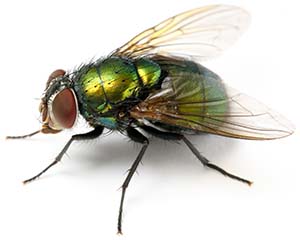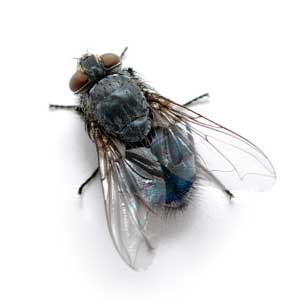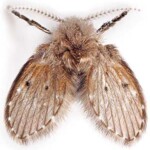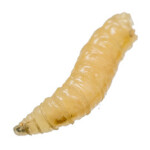FLIES ARE NOT THE PROBLEM, THEY ARE THE RESULT OF A PROBLEM
Blow Flies
 Blow flies are slightly larger than your typical house fly. Blow fly adults are about 1/8-5/8’’ long with a metallic bronze, green, or bluish tint to them. They have elbowed veins in their wings and will make a buzzing sound when they fly. Blowflies breed and develop in decaying matter such as roadkill, dead animal carcasses, decaying plants, feces, and garbage. To eliminate blow flies, you must remove the source they are coming from. They are not very common in the home but if you see them inside, they are most likely bred outside before sneaking in. If there is an abundance of them inside your home, then they are most likely coming from a dead animal in your attic or crawlspace. There is no treatment for blow flies. To eliminate the problem is to eliminate the source. Making sure there are no tears or rips in window screens can help prevent an infestation from coming into your home.
Blow flies are slightly larger than your typical house fly. Blow fly adults are about 1/8-5/8’’ long with a metallic bronze, green, or bluish tint to them. They have elbowed veins in their wings and will make a buzzing sound when they fly. Blowflies breed and develop in decaying matter such as roadkill, dead animal carcasses, decaying plants, feces, and garbage. To eliminate blow flies, you must remove the source they are coming from. They are not very common in the home but if you see them inside, they are most likely bred outside before sneaking in. If there is an abundance of them inside your home, then they are most likely coming from a dead animal in your attic or crawlspace. There is no treatment for blow flies. To eliminate the problem is to eliminate the source. Making sure there are no tears or rips in window screens can help prevent an infestation from coming into your home.
Cluster/Buckwheat Flies
 Adult cluster flies, also known as buckwheat flies, are larger than the common house fly. These robust, non-metallic, dark gray flies have overlapping wings and are about 3/8’’ with short golden hairs. These very stagnant, sluggish pests are not destructive but can be a nuisance in your home. If they are crushed, they put off a buckwheat honey odor. When temperatures start to drop at night in late August and early September, these home invaders seek shelter to get out of the cold. They will harbor in the cracks and crevices of your home to hibernate and will come out on sunny, warm days-usually around your windows.
Adult cluster flies, also known as buckwheat flies, are larger than the common house fly. These robust, non-metallic, dark gray flies have overlapping wings and are about 3/8’’ with short golden hairs. These very stagnant, sluggish pests are not destructive but can be a nuisance in your home. If they are crushed, they put off a buckwheat honey odor. When temperatures start to drop at night in late August and early September, these home invaders seek shelter to get out of the cold. They will harbor in the cracks and crevices of your home to hibernate and will come out on sunny, warm days-usually around your windows.
Click here to learn about our Fall & Winter Home Invaders Prevention service.
Drain Flies
 Drain flies get their name from where they breed and develop – in drains. They are more of a nuisance than anything. They are tan, light gray, or brownish black with hairy bodies that are 1/16-3/16’’. These flying insects have oval wings with a darker brown to black outline. Drain flies are commonly mistaken as a smaller version of a moth. If sinks or drains are not often used, then the slime and sludge that builds up with hair is a prime place for drain flies to live and breed. Cleaning sinks/drains on a weekly basis can help eliminate and prevent infestations.
Drain flies get their name from where they breed and develop – in drains. They are more of a nuisance than anything. They are tan, light gray, or brownish black with hairy bodies that are 1/16-3/16’’. These flying insects have oval wings with a darker brown to black outline. Drain flies are commonly mistaken as a smaller version of a moth. If sinks or drains are not often used, then the slime and sludge that builds up with hair is a prime place for drain flies to live and breed. Cleaning sinks/drains on a weekly basis can help eliminate and prevent infestations.
Fruit Flies & Gnats

FRUIT FLIES VS GNATS
Fruit Flies and gnats are more of a nuisance than anything. Although they are both about an 1/8’’ in size they are quite different. They both reproduce quickly, so getting rid of the source they are coming from is essential. Fruit Flies are lighter in color than gnats. They can be tan, brown to black with red or black eyes. Whereas gnats are darker in color with brown, dark gray, or black tint and dark eyes. Fruit Flies have round bodies, whereas gnats have a longer body with dangling legs. Fruit flies and gnats are attracted to decaying food or plant matter. If they have reached adulthood that means their larvae are developing in the fermenting material. The main difference is the location where they breed.
House Flies
 House flies are more of a nuisance than anything else. They do live and breed on decaying matter and can transfer bacteria and pathogens with their sponge like mouth parts. They are a dull gray color with four black stripes on their thorax (segment between head and body) with two elbow-veined wings. They are 1/8-1/4’’ with the females being larger in size than the males. Adult house flies can only live 15-60 days but reproduce very quickly. Females can lay up to 500 eggs in their lifetime. They can produce anywhere there is a suitable food source, typically decaying organic matter or feces. The larvae, also known as maggots, are white to yellow in color and will continue to feed off the decaying matter until they reach the pupae stage. When in the pupae stage they contain themselves in a brown, hard shell, where they develop their wings and legs. Once developed they will merge as an annoying house fly.
House flies are more of a nuisance than anything else. They do live and breed on decaying matter and can transfer bacteria and pathogens with their sponge like mouth parts. They are a dull gray color with four black stripes on their thorax (segment between head and body) with two elbow-veined wings. They are 1/8-1/4’’ with the females being larger in size than the males. Adult house flies can only live 15-60 days but reproduce very quickly. Females can lay up to 500 eggs in their lifetime. They can produce anywhere there is a suitable food source, typically decaying organic matter or feces. The larvae, also known as maggots, are white to yellow in color and will continue to feed off the decaying matter until they reach the pupae stage. When in the pupae stage they contain themselves in a brown, hard shell, where they develop their wings and legs. Once developed they will merge as an annoying house fly.

Pest Info
